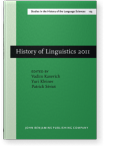Western grammars of the Chinese language in the 18th and 19th centuries
Studies on ‘cenemes’ and word formation
The development of studies on Chinese grammar was an important innovation of European sinology, as the systematic descriptions of the language were scarcely represented in native tradition. The genre of bilingual grammars involved adapting the methodologies elaborated for Western languages to Chinese. Even though the Western model was predominant, bilingual grammars progressively integrated aspects of Chinese linguistics. Moreover, in their attempt to give an account of the specific features of Chinese, missionaries and scholars also developed new categories and theories, absent both in Latin and Chinese traditions. In this paper, we aim to retrace the evolution of the Western grammars of Chinese during the 18th and 19th centuries, by focusing particularly on the interplay between the analytical models of European origin and the descriptive obligations for the specific features of the Chinese language.
References (19)
References
Abel-Rémusat, Jean-Pierre. 1822. Élémens de la grammaire chinoise. Paris: ImprimerieRoyale. (Repr. in Paris: Ala production 1987).
Bazin, Antoine. 1845. Mémoire sur les principes généraux du chinois vulgaire, Paris: Imprimerie Royale.
Bridgman, James G., transl. 1847. The Notitia Linguae Sinicae of Prémare translated into English. Canton: Office of the Chinese Repository.
Brollo, Basilio. 1714. Hán çsú sγ yĕ-Sinicorum Characterum Europea Expositio. Paris, Bibliothèque nationale de France, Chinois 9279.
Duanmu, San. 1998. “Wordhood in Chinese”. New Approaches to Chinese Word formation, ed. by Jerome Lee Packard, 136–195. The Hague: Mouton de Gruyter.
Hu, Qiguang 胡奇光. 1987. Zhongguo xiaoxue shi 中国小学史 [History of Chinese philology]. Shanghai: Renmin.
Julien, Stanislas. 1869. Syntaxe nouvelle de la langue chinoise. Paris: Maisonneuve.
La Charme, Alexandre, transl., Mohl, Jules, ed. 1830. Confucii Chi-King, sive Liber carminum. Stuttgart and Tübingen: J. B. Cotta
Marsham, Joshua. 1814. Elements of Chinese Grammar. Serampore: Mission Press.
Packard, Jerome Lee. 1998. “Introduction”. New Approaches to Chinese Word formation, ed. by Jerome Lee Packard, 1–34. The Hague: Mouton de Gruyter. 

Packard, Jerome Lee. 2000. The Morphology of Chinese: A Linguistic and Cognitive Approach. Cambridge: Cambridge University Press. 

Pan, Wengguo 潘文国, Po-ching Yip 叶步青 & Saxena Yang Han 韩洋. 1993. 汉语的造词法研究
[Studies of Chinese Word-Formation]
. Taipei: Student Book.
Perny, Paul. 1873–1876. Grammaire de la langue chinoise orale et écrite (two volumes). Paris: Maisonneuve; Ernest Leroux.
Peverelli, Peter J. 1986. The History of Chinese Grammar Studies. Ph.D. dissertation, University of Leiden.
Peyraube, Alain. 2001. “Some reflections on the sources of the Mashi Wentong”. New Terms for New Ideas. Western Knowledge and Lexical Change in Late Imperial China, ed. by Michael Lackner, Iwo Amelung & Joachim Kurtz, 341–356. Leiden: Brill.
Prémare, Joseph Henry. 1831. Notitia Linguae Sinicae, Malacca: Cura Academia Anglo-Sinensis.
Yip, Po-ching. 2000. The Chinese Lexicon: a Comprehensive Survey. London & New York: Routledge.
Zhou, Jian 周荐. 1995. Hanyu cihui yanjiu shigang. 汉语词汇研究史纲 [An Historical Outline of the Studies on Chinese Lexicon]. Beijing: Yuwen.
Cited by (2)
Cited by two other publications
Durymanova, A. D.
2022.
Argument Distinctive Context Functioning of 被 bei (Based on the Material of the Late Classical Chinese Text – “Lunheng”)..
Vestnik NSU. Series: History and Philology 21:4
► pp. 114 ff.

Gianninoto, Mariarosaria
2021.
L’apprentissage du chinois langue étrangère (CLE) par des publics spécialisés entre le XVIIe et le XIXe siècle.
Documents pour l'histoire du français langue étrangère ou seconde :66-67

This list is based on CrossRef data as of 30 october 2024. Please note that it may not be complete. Sources presented here have been supplied by the respective publishers.
Any errors therein should be reported to them.
